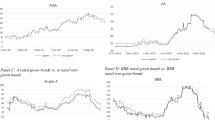Abstract
This study examines if a CEO’s age and education explain introduction of hedging in the oil and gas industry. We compare CEO age, college degree, and educational institutions between the hedgers that initiated use of derivatives and the nonhedgers that never used hedging. Our findings show that a hedge CEO is younger than a nonhedge CEO in the year hedging is initiated. We also find evidence that a higher percentage of the hedge CEOs have petroleum-related degrees and a smaller percentage have business degrees when compared to the nonhedge CEOs. The results of our logistic regressions indicate that CEO age explains the use of financial derivatives in the oil and gas industry.


Similar content being viewed by others
Notes
As a test of robustness, we use age of nonhedge CEO in the year of first data availability on 10-k filings in SEC Edgar or Standard and Poor’s MergentOnline database. The mean age for the nonhedge CEOs is 56.41 years which is significantly different (at the 1 % level) from the mean age for the hedge CEOs. We also compare the introduction age of a hedge CEO against the age of a nonhedge CEO in the first year of a major decline in adjusted WTI during the sample period. The results are qualitatively similar.
References
Al-Mudhaf A, Goodwin TH (1993) Oil shocks: evidence from the 1970s. Appl Econ 25:181–190
Barker VL III, Mueller GC (2002) CEO characteristics and Firm R&D spending. Manag Sci 48:782–801
Bhagat S, Bolton B, Subramanian A (2011) CEO education, CEO turnover, and firm performance. No. DN-V3N10, Director Notes, The Conference Board, 1–9
Bredin D, Elder J (2011) US oil price exposure: the industry effects. UCD Geary Institute, Discussion Paper Series, Geary WP2011/07
Cronqvist H, Makhija AK, Yonker SE (2012) Behavioral consistency in corporate finance: CEO personal and corporate leverage. J Financ Econ 103:20–40
Davis SJ, Haltiwanger J (2001) Sectoral job creation and destruction responses to oil price changes. J Monet Econ 48:465–512
Gogineni S (2010) Oil and the stock market: an industry level analysis. Financ Rev 45:995–1010
Gottesman AA, Morey MR (2010) CEO educational background and firm financial performance. J Appl Finance:70–82.
Graham JR, Harvey CR, Puri M (2010) Managerial attitudes and corporate actions. Working Paper, Duke University
Hambrick DC, Mason PA (1984) Upper echelons: the organization as a reflection of its top managers. Acad Manag Rev 9:193–206
Haushalter GD (2000) Financing policy, basis risk, and corporate hedging: evidence from oil and gas producers. J Financ 55:107–152
Holmstrom B (1999) Managerial incentive problems: a dynamic perspective. Rev Econ Stud 66:169–182
Jalbert T, Rao R, Jalbert M (2002) Does school matter? An empirical analysis of CEO education, compensation, and firm performance. Int Bus Econ Res J 1:83–98
Jin Y, Jorion P (2006) Firm value and hedging: evidence from U.S. oil and gas producers. J Financ 61:893–919
Malmendier U, Nagel S (2011) Depression babies: do macroeconomic experiences affect risk taking? Q J Econ 126:373–416
Malmendier U, Tate G (2005) CEO overconfidence and corporate investment. J Financ 60:2661–2700
Malmendier U, Tate G (2008) Who makes acquisitions? CEO overconfidence and the market’s reaction. J Financ Econ 89:20–43
Malmendier U, Tate G, Yan J (2011) Overconfidence and early-life experiences: the effect of managerial traits on corporate financial policies. J Financ 66:1687–1733
Mian S (2001) On the choice and replacement of chief financial officers. J Financ Econ 60:143–175
Mohanty SK, Nandha M (2011) Oil risk exposure: the case of the U.S. oil and gas sector. Financ Rev 46:165
Nance DR, Smith CW, Smithson CW (1993) On the determinants of corporate hedging. J Financ 48:267–284
Prendergast C, Stole L (1996) Impetuous youngsters and jaded old-timers: acquiring a reputation for learning. J Polit Econ 104:1105–1134
Scholtens B, Wang L (2008) Oil risk in oil stocks. Energy J 29:89–112
Serfling MA (2012) CEO age and the riskiness of corporate policies. Working Paper, University of Arizona–Eller College of Management
Zwiebel J (1995) Corporate conservatism and relative compensation. J Polit Econ 103:1–25
Author information
Authors and Affiliations
Corresponding author
Rights and permissions
About this article
Cite this article
Iqbal, Z. CEO age, education, and introduction of hedging in the oil and gas industry. J Econ Finan 39, 189–200 (2015). https://doi.org/10.1007/s12197-013-9274-y
Published:
Issue Date:
DOI: https://doi.org/10.1007/s12197-013-9274-y




